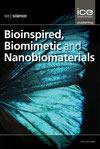Inspired by mussel: biomimetic polyelectrolyte complex coacervate adhesive initiates a connection through water exchange
IF 0.6
4区 工程技术
Q4 ENGINEERING, BIOMEDICAL
引用次数: 0
Abstract
Here the authors report a versatile and strong underwater adhesive that was inspired by the chemical features of mussel foot proteins. A random copolymer (poly(N-(3,4-dihydroxyphenethyl)methacrylamide-co-methacryloxyethyltrimethyl ammonium chloride-co-acrylamide) (PDMA)–Tf2N) was prepared that contained side-chain catechol groups and quaternary ammonium cations that were ion-paired with bis(trifluoromethane-sulfonyl)imide anion (Tf2N−). After dissolving PDMA–Tf2N and poly(acrylic acid) in dimethyl sulfoxide, a polyelectrolyte complex coacervate adhesive (P2) could be formed, which could be triggered through solvent exchange. P2 exhibited outstanding underwater shear strength to various substrate surfaces. After a critical curing time (t s = 10 min), the adhesion strength of P2 to glass increased sharply up to 187.298 kPa (t s = 40 min).灵感来自贻贝:仿生聚电解质复合物凝聚胶通过水交换启动连接
在这里,作者报告了一种多功能和强大的水下粘合剂,其灵感来自贻贝足蛋白质的化学特性。制备了一种无规共聚物(聚(N-(3,4-二羟基苯基)甲基丙烯酰胺-共甲基丙烯氧氧乙基三甲基氯化铵-共丙烯酰胺)(PDMA) - Tf2N),其侧链儿茶酚基团和季铵盐阳离子与双(三氟甲烷-磺酰)亚胺阴离子(Tf2N−)离子配对。PDMA-Tf2N与聚丙烯酸在二甲亚砜中溶解后,形成聚电解质络合物凝聚胶(P2),通过溶剂交换触发。P2对各种基材表面均表现出优异的水下抗剪强度。经过临界固化时间(t s = 10 min)后,P2与玻璃的粘附强度急剧增加,达到187.298 kPa (t s = 40 min)。
本文章由计算机程序翻译,如有差异,请以英文原文为准。
求助全文
约1分钟内获得全文
求助全文
来源期刊

Bioinspired Biomimetic and Nanobiomaterials
ENGINEERING, BIOMEDICAL-MATERIALS SCIENCE, BIOMATERIALS
CiteScore
2.20
自引率
0.00%
发文量
12
期刊介绍:
Bioinspired, biomimetic and nanobiomaterials are emerging as the most promising area of research within the area of biological materials science and engineering. The technological significance of this area is immense for applications as diverse as tissue engineering and drug delivery biosystems to biomimicked sensors and optical devices.
Bioinspired, Biomimetic and Nanobiomaterials provides a unique scholarly forum for discussion and reporting of structure sensitive functional properties of nature inspired materials.
 求助内容:
求助内容: 应助结果提醒方式:
应助结果提醒方式:


